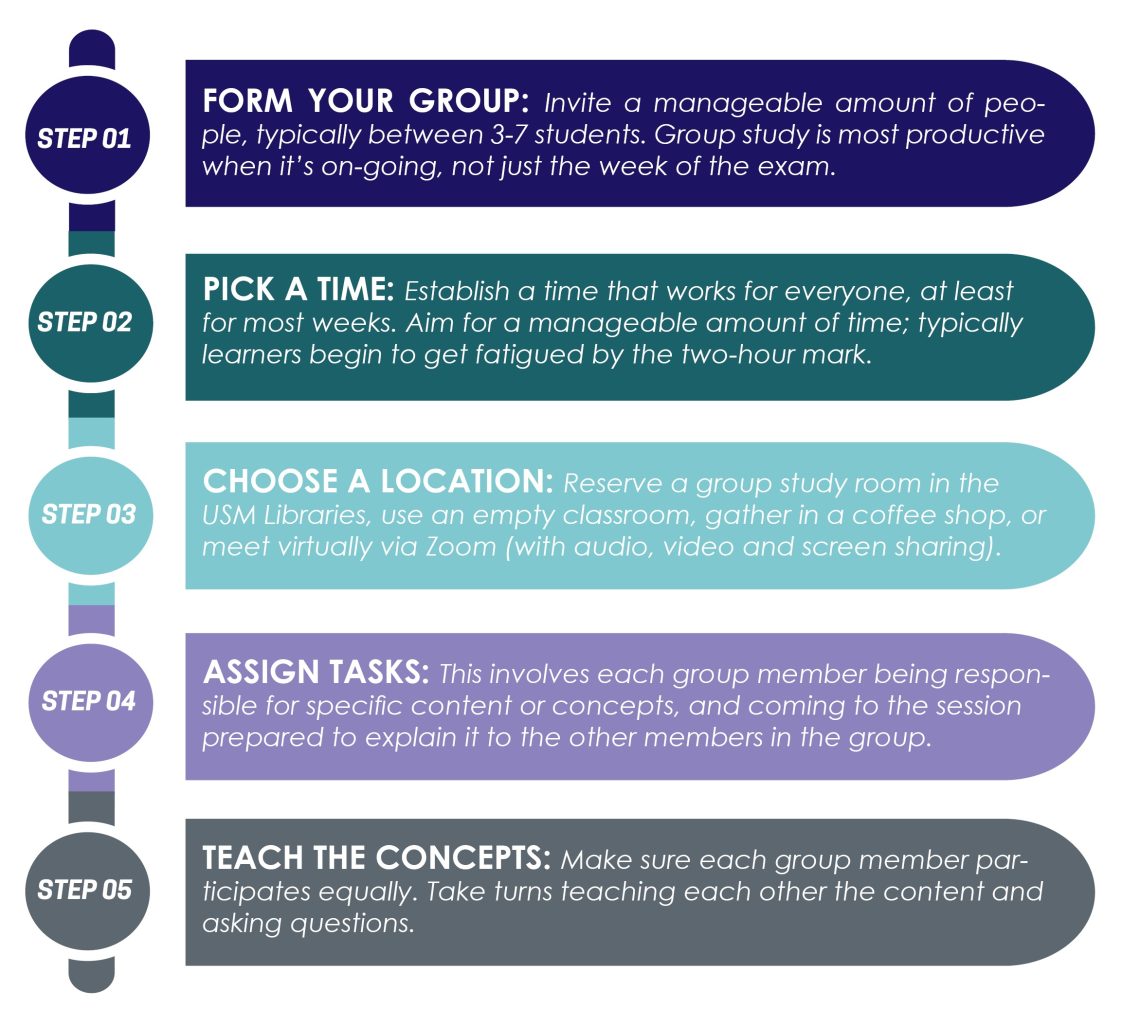
What does it mean to study in a group?
It would be more accurate to say “learn” in a group, since the term “study” often is perceived to be a solo activity. Some students think that “study groups” are about working on a one-time project together, while others believe it means gathering in the same room to “study” at the same time, with each person working on their own. However, as an active learning strategy, studying in a group means meeting regularly with others from the class to teach each other concepts, ask challenging questions, predict exam questions, and debrief an exam. What are the benefits?
Studying in groups is one of the best active learning strategies! The benefits include:
How do I use this approach?
Here are the steps for incorporating group study into your learning efforts:
- Start as early in the semester as possible. Make it a regular part of your academic time-on-task each week. Group study is most productive when it is ongoing, not just the week of an exam.
- Invite a manageable amount of people to participate, typically between 3-7 students. Remember that studying with friends can sometimes be more of a distraction, as it can be easier to get off-task.
- Establish a meeting time that will work for everyone in the group, at least for most weeks. Aim for a manageable amount of time for each meeting; typically learners begin to get fatigued by the two-hour mark, a tipping point for being productive.
- Choose your location. There are several locations on all three USM campuses for groups of students to work together. You will want to choose a space where noise (your interaction with others) is welcomed. This may include group study rooms in the USM Library, unoccupied classrooms, the campus center, lounges in the residence halls, or a local coffee shop.
- Set a goal for each study session. A plan means determining SPECIFIC content to be reviewed or concepts to be discussed. Setting a goal together ahead of time can help prepare everyone for the group study session.
- Agree to the expectation that EVERY MEMBER will be fully prepared and committed for the study session. This involves each group member completing the assigned reading, taking and reviewing notes on the reading and during class, coming to the session ready to explain concepts to other group members, and arriving at the session with any questions about the agreed-upon content/concepts.
- Be interactive throughout the study group meeting. Make sure that each group member participates for an equal amount of time. Ask and answer each others’ questions. Create quizzes on the material for the group to tackle together. Take turns teaching each other pre-assigned amounts of the chapter/concepts. Create a mind map together to show how concepts are related.
REMEMBER: IF YOU CAN TEACH THE INFORMATION EFFECTIVELY AND ACCURATELY, THEN YOU KNOW IT!
Are there any related technologies?
To keep track of the plan for each study session and to share information together throughout the semester, Google Docs is a great way to collaborate, as every USM student has a Google account. Another aspect of group study that can be assisted by technology is the challenge of distance. Consider meeting via Zoom to connect live with audio, video, screen sharing, and document sharing, all with the ability of having several people working together at once. Every USM student has free access to Zoom through the MyUSM portal. The entire study session can also be recorded for later review, or to share with a study group member who could not attend that meeting.
Also, consider using the “Study Buddy” feature in your Navigate USM account to connect with other students in your enrolled courses. Visit the Dean of Students’ Navigate page to learn how to download the app, explore its features, and find your “study buddies” this semester!
Where can I get more information?
The approach of studying in groups is similar to working with a tutor, as all tutors at USM’s Learning Commons are trained to engage students in the process of self-testing and explaining concepts. Consider scheduling a tutoring appointment, or inviting a tutor to join one of your first group study sessions. If it would be helpful to have someone show you how to use Google Docs or Zoom, you can schedule a time with a Technology Coach via the Scheduling an Appointment page. There are also how-to video modules in UMS Academy (within your MyUSM portal).
Meet with a Trained Peer
When it comes to learning, it’s what you DO that matters. Learning with a peer fosters self-testing for understanding, connecting concepts, and improving memory. At USM, there is an entire team of peers to assist with a wide array of learning goals.
*Return to the Study Skills & Learning Strategies homepage


